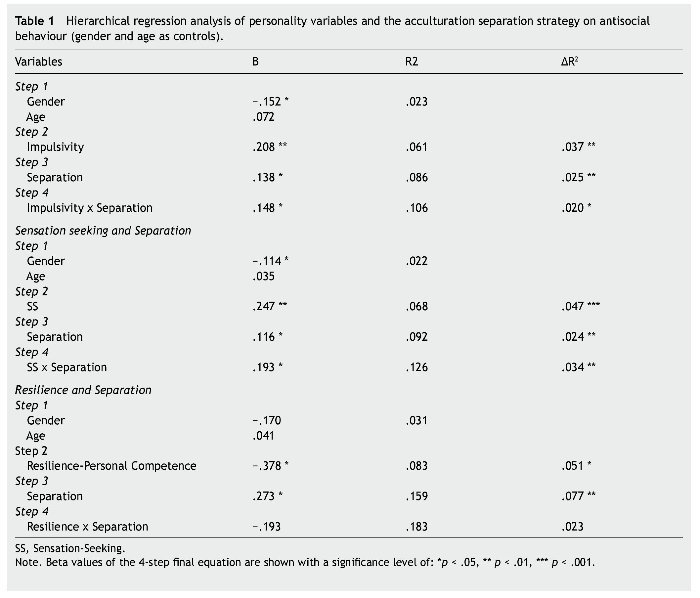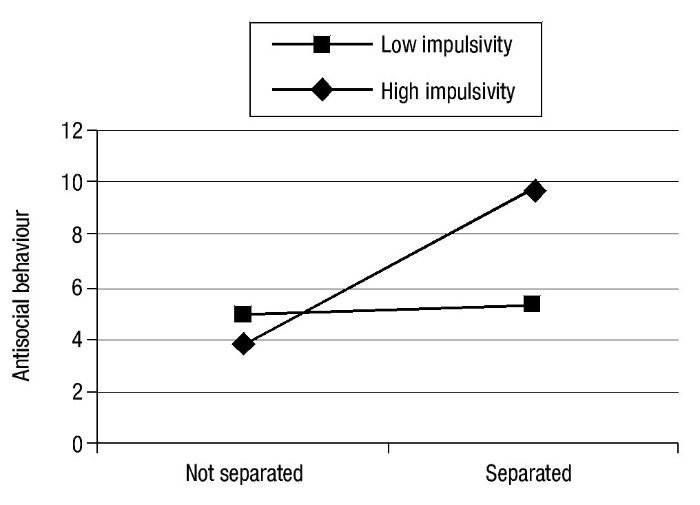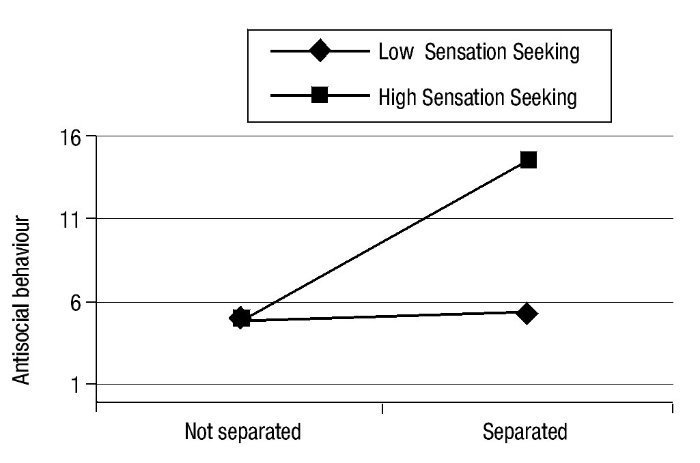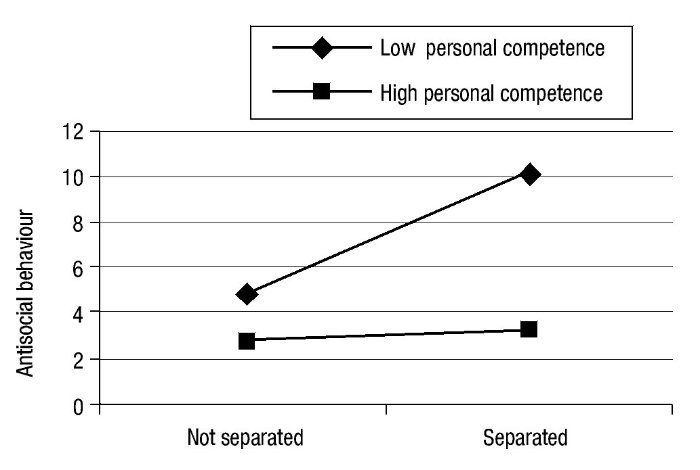Este trabajo tiene como principal objetivo estudiar cómo las variables de personalidad y la aculturación interactúan a la hora de predecir la conducta antisocial de adolescentes inmigrantes en España. Estudios previos mostraron que la estrategia aculturativa llamada separación (rechazo por la cultura de acogida, con un fuerte aprecio por la preservación de la de origen) es la más relacionada con la conducta antisocial inmigrante. Este estudio examina si esa relación está moderada por variables de personalidad, particularmente por la impulsividad, la búsqueda de sensaciones y la competencia personal. Para ello, a través de escalas auto-informadas, previamente validadas, se recogieron datos en una muestra de 750 adolescentes inmigrantes en Galicia y Madrid. Los resultados mostraron que tanto la separación como las variables de personalidad están significativamente asociadas a la conducta antisocial. Además, los análisis de regresión jerárquica, que incluyen términos de interacción, mostraron potentes efectos de moderación: la relación entre separación y conducta antisocial se amplifica notablemente cuando la impulsividad o la búsqueda de sensaciones son elevadas. Estos resultados alertan sobre la necesidad de estudiar los complejos efectos conjuntos entre personalidad y aculturación cuando se trata de explicar los problemas de adaptación en jóvenes inmigrantes.
The primary aim of this study was to assess the interaction between personality and acculturation variables in predicting antisocial behaviour among adolescent immigrants living in Spain. Previous studies have shown that the acculturation style referred to as separation (rejection of the host country's culture, and a strong desire to preserve the culture of the country of origin) was strongly related to antisocial behaviour among immigrants. A further aim of this study was to examine if the relationship between separation and antisocial behaviour was moderated by personality variables, in particular impulsivity, sensation-seeking, and personal competence. Self-reported data of a sample of 750 adolescent immigrants living in Galicia's and Madrid's regions (Spain) were gathered using previously validated scales. The results revealed that both separation and personality variables were significantly related to antisocial behaviour. Moreover, hierarchical regression analysis with the interaction terms entered found significant moderating effects i.e., the relationship between separation and antisocial behaviour was significantly amplified when impulsivity or sensation-seeking were high. The results underscore the need to examine the effects of personality, acculturation, and the interaction between both on antisocial behaviour among adolescent immigrants.
Though migratory flows have been constant through the centuries, these demographic shifts are witnessing unprecedented growth as a result of globalisation, and the prevailing economic downturn. According to the United Nations, migratory populations are predicted to increase significantly in the near future (United Nations Population Division, 2002). Undoubtedly, assessing such a highly complex issue is a daunting task that can be approached from several perspectives ranging from the purely political through to the strictly psychological, with numerous intermediate stances. The diversity of approaches has often been the source of considerable controversy i.e., most psychological approaches have focused on the individual dimension of the migratory experience, which has been severely criticised for being reductionist, and for disguising the true relationship between migration, and political and economic factors. In other words, it is an attempt to classify as psychological what are legitimate manifestations of social injustice, the imbalance of power, xenophobia, and racial discrimination. This view is embodied by Liberation Psychology (e.g., Albar et al., 2010; Paloma & Manzano-Arrondo, 2011). Similarly, compatible ideas have been proposed in the analysis of the process of constructing devaluated, peripheral and humiliated humanities (Sobral, Gómez-Fraguela, Luengo, & Romero, 2010).
Nevertheless, in this study a different but compatible and complementary conceptual framework was adopted. The immigrant population in Spain has risen sharply, but is currently peaking off due to the economic downturn. In less than a generation, Spain has leapt from being a population of immigrants to a land of migration. For instance, school attendance records from the Youth in Spain Report (Instituto de la Juventud de España, 2008) are good evidence of the significant rise in the immigrant population (e.g., the number of non-university students grew from 0.54% in 1992-1993 to 8.5% in 2006-2007). Thus, similar to other
industrialised countries, Spain has become a multicultural society undergoing a process of acculturation, a two-way process of cultural and psychological adjustment derived from the interaction between diverse cultures. Though initially the concept was drawn from anthropology during the early part of the 20th century (Redfield, Linton, & Herskovits, 1936), it has proved to be useful in understanding the changes arising from the direct and intense intercultural contact. In the field of psychology, several of the extensively used models have been based on this concept (Berry, 1997; Berry, Phinney, Sam, & Vedder, 2006). In short, Berry´s central idea is the existence of certain individual difference in the strategies individuals use when they encounter the migratory experience and the subsequent cultural shock. These strategies are as follows: a) integration, defined as engaged in both the culture of origin and the host culture with a positive attitude towards both cultural heritages; b) assimilation, understood as the acceptance and positive attitudinal predisposition towards the host culture, and rejection or neglect of the culture of the country of origin; c) separation, rejection of the host environment, with exalted and idealized views of the culture of the country of origin. This strategy reinforces nostalgic reactive patterns (e.g., Sobral, Gómez-Fraguela, Luengo, Romero, & Villar, 2010) that are known to significantly influence internalising and externalising processes; and d) marginalisation, predominantly negative attitudes towards both cultural contexts.
It should be borne in mind that the term strategy is not to be understood as an attempt to neglect or overlook socio-political factors by focusing on volitional or rational explanations i.e., a solipsistic exercise of free will in a social vacuum. Berry (2005) has clarified successful integration is only genuine if the dominant group renounce their expectations of assimilating the incoming culture.
Acculturation coping strategies have been linked to an array of variables associated to normality, antisocial behaviour, and psychopathology. The main aim of this study was to assess acculturation strategy of separation in relation to personality variables and antisocial behaviour in a sample of 750 Latin American immigrants living in Spain. This study did not seek to stigmatise immigrant communities by suggesting they were the source of most delinquency. In fact, a study undertaken on a sample of 2,400 Spanish and Latin American adolescents living in Galicia and Madrid found that, with the exception of aggressive behaviour, levels of antisocial behaviour were lower among adolescent immigrants than among native adolescents (Gómez-Fraguela, Sobral, Luengo, Romero, & Villar, 2009). The relationship between certain personality variables and antisocial behaviour in adolescents and adults (and the relationship between adolescent antisocial behaviour and future serious offences) has been extensively documented in the scientific literature (Estevez & Emler, 2011; Le Corff & Toupin, 2009, 2010; Sobral, Luengo, Gómez-Fraguela, Romero, & Villar, 2007; Van Dam, Janssens, and De Bruyn, 2005).
Moreover, several types of antisocial behaviour in adolescents have been related to unproductive coping styles (i.e., avoiding problems rather than solving them; Gómez-Fraguela, Luengo, Romero, & Villar, 2006). Hence, the need to assess the role of coping styles, derived from the adolescent's perceptions of their own personal skills and social competence, on antisocial behaviour and the acculturation of adolescent immigrants, particularly since studies on adolescents have underlined the significance of personality variables on antisocial behaviour (Arce, Seijo, Fariña, & Mohamed-Mohand, 2010). Indeed, the literature has extensively focused on the notion of acculturation stress, coping strategies, and the impact on internalising and externalising behaviour (Bhugra, 2004; Collazos, Qureshi, Antonin, & Tomás-Sábado, 2008).
Thus, the primary aim of this study was to assess the relationship between psychobiological or temperamental personality variables (impulsivity and sensation-seeking), perceptions of personal competence, antisocial behaviour, and their interaction with acculturation strategy of separation. As the separation strategy has often been associated to high levels of antisocial behaviour (Sobra, Gómez-Fraguela, Luengo, Romero, & Villar, 2010); Sobral, Gómez-Fraguela, Romero, Luengo, & Villar, 2012), the direct and moderating relations of personality variables and the separation strategy on antisocial behaviour were analysed. A significant interaction was hypothesized, similarly to another study with personality and psychosocial factors on a different population (Sobral, Romero, Luengo, & Marzoa, 2000). The writing of this paper has followed the guidelines of Hartley (2012) and Jarde, Losilla, and Vives (2012).
Method
Participants
The sample consisted of 750 adolescent immigrants from 15 countries ranging from Ecuador with the highest number (35% of the sample) and Colombia (20.5%), to the Dominican Republic (7.5%), Argentina (7.1%), Perú (6.7%), Bolivia (5.9%), and Uruguay (5.2%) accounting for the smallest percentages of the sample. Of the total 750 adolescent immigrants (53.4% were male and 46.6% female, average age 14.3 years (ranging from 11 and 17 years), 477 were recruited in Madrid and 276 in Galicia.
Instruments
As for the categories of immigrant acculturation strategies, the Acculturation Attitudes Scale was used (Berry et al., 2006). This scale consists of 20 items on a 5-point Likert-type scale (ranging from Strongly agree to Strongly disagree) regarding several cultural aspects from the origin and the host countries (traditions, social activities, friends, partner, and language that were grouped into four 5-item subscales for assessing the different strategies: assimilation, integration, separation, and marginalisation. These subscales represent the four different acculturation strategies immigrants may adopt when coping with the so-called culture shock between origin and host cultures. This study focused on the separation acculturation strategy which was assessed by the separation subscale with an internal consistency of α = .67.
The Impulsivity Scale of Questionnaire I6, originally designed by Eysenck, Easting, and Pearson (1984) adapted in Spain by Silva, Martorell, and Clemente (1987) was used to assess Impulsivity. The internal consistency obtained in this study was α = .80. To assess Sensation-seeking, the 10-item scale of the ZKPQ-III Questionnaire was used, with an internal consistency of α = .73. In both cases, a dichotomous (yes/no) response format was used.
Personal competence was assessed using a brief version of the ad hoc subscale of the Resilience Scale (Wagnild & Young, 1993). The scale was composed of four items which explore the subject's beliefs regarding his/her competence for problem-solving, the ability to act under pressure, and the subject´s appraisal of himself/herself in response to the demands of his/her environment. The internal consistency was α = .92.
A short version of the Antisocial Behaviour Questionnaire (CCA; Luengo, Otero, Romero, Gómez-Fraguela, & Tavares-Filho, 1999) was used to assess antisocial behaviour. The questionnaire was composed of self-report questions on the frequency of the adolescent´s antisocial behaviour for the last 12 months: a) aggressive behaviour (e.g., to provoke fights); b) vandalism (e.g., intentional destruction of street furniture); c) rule-breaking (e.g., to stay outside overnight without permission); d) thefts (e.g., in stores); and e) illicit substance abuse (delinquent behaviour aimed at getting drugs for personal consumption and/or for drug dealing). The four possible response options were never, sometimes - 1 to 5 times, often - 5 to 10 times, and very often, 10 times or more. The internal consistency in the different scales was .80 for aggressive behaviour, .77 for vandalism, .73 for rule-breaking and .50 for both thefts and illicit substance abuse.
Procedure
The participants in the study were recruited from different state secondary schools in Galicia's and Madrid's regions. In Galicia, 21 schools with more presence of immigrants were selected (source: statistical data provided by the Department of Education of the Xunta de Galicia, the Autonomous Government of Galicia). As for the Madrid region, data were collected from 9 schools in 3 towns with a large number of Latin American immigrants. For this study, the inclusion criteria were that the adolescent and both parents should be born in any Latin American country.
This research was presented to the administrators of the selected schools. They were explained its main features and objectives of the study and were asked for collaboration. After all school administrators having expressed willingness to cooperate, the adolescents were asked for collaboration, after having obtained parental approval. Questionnaires were administered collectively in a 60-minute session in the students´ habitual classrooms during school hours. All of the participants freely volunteered, and were once again assured their data would remain anonymous and confidential. Questionnaire administration was supervised by members of the research team, and school teachers were not present at any time.
Data analysis
First, hierarchical regressions were performed with the personality variables, the separation acculturation strategy, and the interaction between both as predictors. The antisocial behaviour scores of immigrant adolescents were used as the criterion variable.
Moreover, taking into account the results of the regression, an analysis of variance (ANOVA) with two factors was carried out to determine the impact of personality variables on separation as an acculturation strategy, and its influence on antisocial behaviour. To perform the ANOVA, the personality and separation variables were dichotomized using the 75th percentile of the distribution (third quartile) as cut-off point.
Results
Table 1 shows the results of the hierarchical regression analysis of personality variables and their interaction with the separation strategies. Each personality variable was independently entered. Gender and age were entered as control variables. The three personality variables were found to be significant predictors of antisocial behaviour. The significant statistical effect of sensation seeking/risk-taking (p < .001) moderates the significance of the separation as an acculturation strategy in the prediction of social deviation. The interactions between sensation seeking and the separation strategy and between impulsivity and the separation strategy were significant. Nevertheless, the interaction between the personal competence resilience factor and the tendency to separation was not statistically significant. These results indicate the psychobiological personal variables (e.g., sensation seeking and impulsivity) and the acculturation strategy (separation) significantly interact and influence antisocial behaviour among immigrant adolescents.
Figs. 1 to 3 show the results for the analysis of variance for two factors assessing the modulating effects of personality variables on the relationship between separation and antisocial behaviour.
Figure 1 Impulsivity x separation interaction.
Figure 2 Sensation-Seeking x separation interaction.
Figure 3 Personal competence and separation interaction.
The modulating and amplifying effect of impulsivity, sensation seeking, and deficits in personal competence can be clearly appreciated in Figures 1, 2, and 3: the effects of separation on antisocial behaviour were stronger for subjects with: a) high impulsivity, F (3, 747) = 5.07; p < .05 (see Fig.1); and b) high sensation seeking (this amplifying effect was significant), F(3, 747) = 12.03; p < .01 (see Fig. 2); c) finally, although the interaction between low personal competence and high levels of separation on antisocial behaviour occurs in the expected direction (Fig. 3), does not reach statistical significance, F(3, 747) = 2.23; n.s.
Discussion
The results corroborated the role of personality variables on antisocial behaviour among adolescent immigrants living in Spain. Thus, the statistical analysis found Impulsivity was related to antisocial behaviour. This trait is related to the subjects' inability to adequately regulate appetitive behaviour (i.e., a balanced regulation of activation and inhibition, which generates low levels of self-control). Hence, the lack of reflective thinking and planning that drive means-ends sequences that project behaviour into the future, the inability to develop consequentialist thinking (and the subsequent inability to use goals and expectations as regulators of immediate decision-making), and the resulting presentism that appears to definitely reside in the core of the temperamental nucleus of individuals predisposed to conflictive interactions with the environment. These results are consistent with other studies on different samples, particularly illicit substance abuse (Luengo, Villar, Sobral, Romero, & Gómez-Fraguela, 2009; Sobral, Gómez-Fraguela, Luengo, Romero, & Villar, 2010; Sobral et al., 2012).
The results for the variable sensation seeking/risk-taking are also consistent with a wide range of empirical studies (Zuckerman, 2008). The search for new, varied, and challenging risk-taking sensations, the difficulty of certain individuals to reach their optimum stimulation, and the subsequent susceptibility to boredom in relation to many common tasks of conventional socialisation draw individuals to risk-taking activities (physical, social, legal). Antisocial behaviour (e.g., illicit substance abuse) is frequently an attractive shortcut for adolescents with these psychobiological and temperamental needs. Moreover, numerous studies have found a strong association between impulsivity and sensation seeking, and both have become so conceptually intertwined that they have been unified into a single impulsive sensation-seeking personality construct (Zuckerman & Kuhlman, 2000).
In addition to the temperamental variables, a more cognitive and affective personality variable was included in this study: Personal competence, an essential component of this protective configuration is resilience. The results of this study confirm that adolescent immigrants with higher levels of antisocial behavioural were characterised by a lack of confidence in their own competences and problem-solving skills, and in acting effectively in undertaking demanding tasks. An inherent feature of the concept of personal competence is the cycle of progressively maladjustment feed-back: underestimating one's own competences hinders problem-solving based on adaptive behaviour. This in turn reinforces perceptions of one's own limitations until, in a pernicious loop, the individual is driven to alternative solutions: defiance of the rules, social exclusion, antisocial behaviour.
A primary objective of this study was to explore the interaction of personality variables and the tendency to adopt a separation acculturation strategy (i.e., aversion to the host cultural, feeling alienated, homesick, exalting the culture of the country of origin). Thus, the results of the regression and analysis of variance revealed significant interactive moderating effects. In recent studies (Sobral, Gómez-Fraguela, Luengo, Romero y Villar, 2010; Sobral et al., 2012) separation was found to be highly related to high levels of antisocial behaviour among immigrants. The results highlight that impulsivity and sensation seeking exert an amplifying effect, and corroborated the finding that high levels of impulsivity and sensation seeking raise the risk of antisocial behaviour in separated adolescents. In all likelihood, this temperamental configuration drives separation, preventing successful integration in the host community, rejecting bonds or ties with prosocial subjects, norms, conventions, and local institutions.
The interaction between personal competence and the separation style and its impact on antisocial behaviour can be explained on similar lines (i.e., adolescent immigrants who live a separation style of acculturation and who consider themselves to be incompetent will tend to exhibit high levels of antisocial behaviour). It should be borne in mind that the results of this study underscored this tendency; however, the interaction between personal competence and separation was not statistically significant.
This study has contributed to the ecological validity of current approaches by combining the assessment of variables that act simultaneously in the real world. Thus, further research is required a) to assess how individual temperamental differences contribute to the adoption of separation strategies of acculturation, b) to corroborate the findings of this studies in other populations of immigrants from other cultural settings and alienated social groups as well as other criteria i.e., the use of official archives such as criminal records and not just self-reports, and c) to identify not only maladjusted profiles but also protective factors and resilience profiles.
Hence, given that immigration is a controversial issue, researches could aim to develop inclusive discourses that building barriers against ethnocentrism, racial prejudice, and xenophobia, particularly in the face of ongoing encroachment on human rights and the dilution of social values (Sobral, Gómez-Fraguela, Luengo, & Romero, 2010), and to safeguard social equality and human rights.
Funding
This research project was funded by the Spanish Ministry of Education and Science (Project SEJ2005-08949).
*Corresponding author at:
Departamento de Psicología Social, Básica y Metodología,
Facultad de Psicología, Campus Sur,
15782 Santiago de Compostela, Spain.
E-mail address:jorge.sobral@usc.es (J. Sobral).
Received May 23, 2012;
accepted September 12, 2012
References
Albar, M. J., García, M., El Karkri, M., Luque, V., Paloma, V., Camacho, C., El Jebari, T., Hernández, S., Paloma, O., & Sevillano, J. M. (2010). Contribuciones de la Psicología de la Liberación a la integración de la población inmigrante. Intervención Psicosocial, 19, 223-234.
Arce, R., Seijo, L., Fariña, F., & Mohamed-Mohand, L. (2010). Comportamiento antisocial en menores: Riesgo social y trayectoria natural de desarrollo. Revista Mexicana de Psicología, 27, 127-142.
Berry, J. W. (1997). Immigration, acculturation and adaptation. Applied Psychology: An International Review, 46, 5-68.
Berry, J. W. (2005). Acculturation: Living succesfully in two cultures. International Journal of Intercultural Relations, 29, 697-712.
Berry, J. W., Phinney, J. S., Sam, D. L., & Vedder, P. (2006). Immigrant youth in cultural transition: Acculturation, identity and adaptation across national contexts. Mahwah, NJ: Lawrence Erlbaum Associates.
Bhugra, D. (2004). Migration and mental health. Acta Psychiatrica Scandinavica, 108, 67-72.
Collazos, F., Qureshi, A., Antonin, M., & Tomás-Sábado, J. (2008). Estrés aculturativo y salud mental en población inmigrante. Papeles del Psicólogo, 29, 307-315.
Estevez, E., & Emler, N. (2011). Assessing the links among adolescent and youth offending, antisocial behavior, victimization, drug use, and gender. International Journal of Clinical and Health Psychology, 11, 269-289.
Eysenck, S. B., Easting, G., & Pearson, P. R. (1984). Age norms for impulsivity, venturesomeness and empathy in children. Personality and Individual Differences, 5, 315-321.
Gómez-Fraguela, J. A., Luengo, M. A., Romero, E., & Villar, P. (2006). Estrategias de afrontamiento en el inicio de la adolescencia y su relación con el consumo de drogas y la conducta problemática. International Journal of Clinical and Health Psychology, 6, 581-597.
Gómez-Fraguela, J. A., Sobral, J., Luengo, M. A., Romero, E., & Villar, P. (2009). El mito del inmigrante delincuente. Boletín Criminológico, 112, 1-4.
Hartley, J. (2012). New ways of making academic articles easier to read. International Journal of Clinical and Health Psychology, 12, 143-160.
Instituto de la Juventud de España (2008). Informe de la juventud en España. http://www.injuve.migualdad.es/injuve/portal.portal.action [accessed 6 Feb 2011].
Jarde, A., Losilla, J. M., & Vives, J. (2012). Suitability of three different tools for the assessment of methodological quality in ex post facto studies. International Journal of Clinical and Health Psychology, 12, 97-108.
Le Corff, Y., & Toupin, J. (2009). Comparing persistent juvenile delinquents and normative peers with the Five-Factor Model of Personality. Journal of Research in Personality, 43, 1105-1108.
Le Corff, Y., & Toupin, J. (2010). The Five-Factor Model of personality at the facet level: Association with antisocial personality disorder symptoms and prediction of antisocial behavior. Journal of Psychopathology and Behavioral Assessment, 32, 586-594.
Luengo, M. A., Otero, J. M., Romero, E., Gómez-Fraguela, J. A., & Tavares-Filho, T. E. (1999). Análisis de ítems para la evaluación de la conducta antisocial: Un análisis transcultural. Revista Iberoamericana de Diagnóstico y Evaluación, 1, 21-36.
Luengo, M. A., Villar, P., Sobral, J., Romero, E., & Gómez-Fraguela, J. A. (2009). El consumo de drogas en los adolescentes inmigrantes: implicaciones para la prevención. Revista Española de Drogodependencias, 34, 448-479.
Paloma, V., & Manzano-Arrondo, V. (2011). The role of organizations in Liberation Psychology: Applications of the study of migrations. Intervención Psicosocial, 20, 309-318.
Redfield, R., Linton, R., & Herskovits, M. (1936). Memorandum on the study of acculturation. American Anthropologist, 38, 149-152.
Silva, F., Martorell, M. C., & Clemente, A. (1987). I6 (junior) questionnaire: Spanish version. Psychological Assessment: An International Journal, 3, 55-78.
Sobral, J., Gómez-Fraguela, J. A., Luengo, M. A., & Romero, E. (2010a). Inmigración: Humanidades periféricas y humillación. A la búsqueda del "paradigma utópico mínimo". Psicología Política, 41, 27-41.
Sobral, J., Gómez-Fraguela, J. A., Luengo, M. A., Romero, E., & Villar, P. (2010). Adolescentes latinoamericanos, aculturación y conducta antisocial. Psicothema, 22, 410-415.
Sobral, J., Gómez-Fraguela, J. A., Romero, E., Luengo, M. A., &
Villar, P. (2012). Riesgo y protección de desviación social en adolescentes inmigrantes: Personalidad, familia y aculturación. Anales de Psicología, 28, 664-674.
Sobral, J., Luengo, M. A., Gómez-Fraguela, J. A., Romero, E., & Villar, P. (2007). Personalidad, género y criminalidad violenta en reclusos. Psicothema, 19, 269-275.
Sobral, J., Romero, E., Luengo, M. A., & Marzoa, J. (2000). Person-alidad y conducta antisocial: Amplificadores individuales de los efectos contextuales. Psicothema, 12, 661-670.
United Nations Population Division (2002). World immigration report. New York, NY: United Nations.
Van Dam, C., Janssens, J., & De Bruyn, E. (2005). PEN, Big Five, juvenile delinquency and criminal recidivism. Personality and Individual Differences, 39, 7-19.
Zuckerman, M. (2008). Sensation seeking and risky behavior. Washington, WA: American Psychological Association.
Zuckerman, M., & Kuhlman, D. M. (2000). Personality and risk-taking: Common biosocial factors. Journal of Personality, 68, 999-1029.
Wagnild, G.M., & Young, H. M. (1993). Development and psycho-metric evaluation of the resilience scale. Journal of Nursing Measurement, 1, 165-178.













